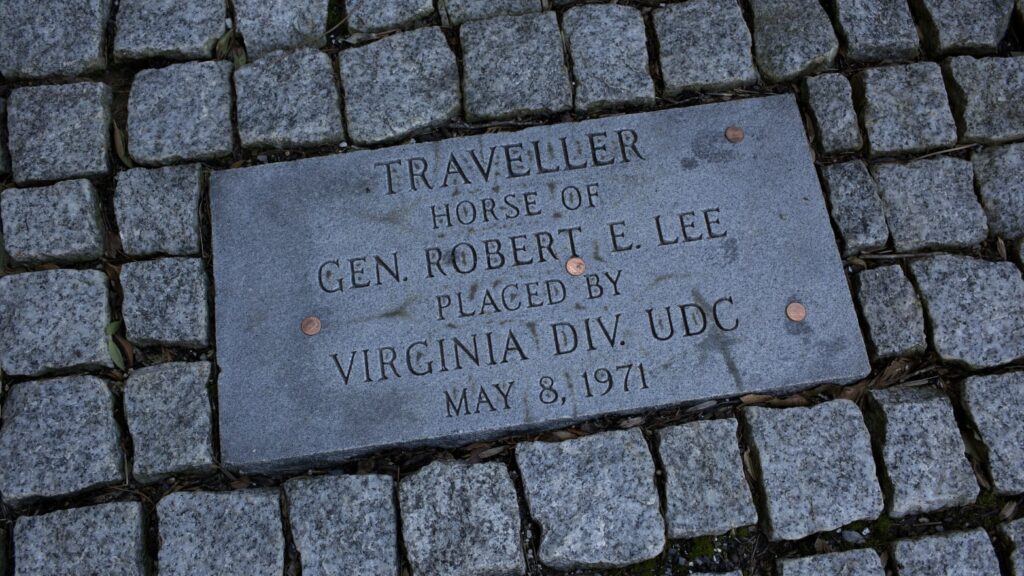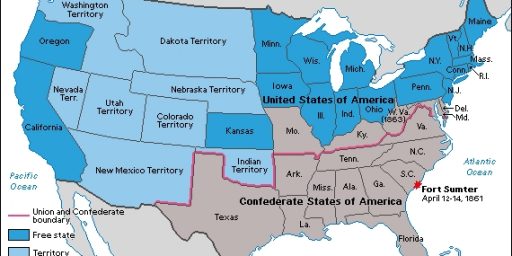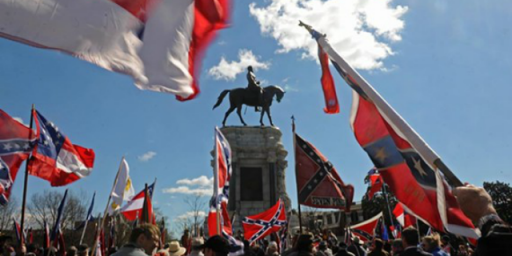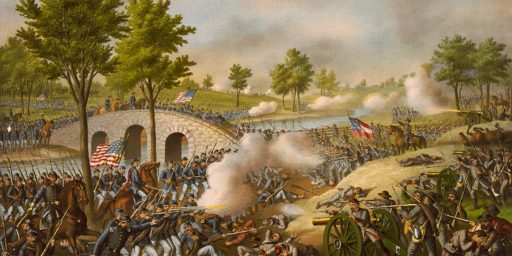Washington and Lee Cancels Lee’s Horse—But Not Lee
A case in misplaced priorities.

The Daily Beast has a rather juvenile report titled “Conservatives Are Mad That Robert E. Lee’s Dead Horse Has Been Canceled.” It starts straightforwardly enough:
Far-right critics have railed against Washington and Lee University for submitting to “cancel culture” after the school removed plaques commemorating a Confederate-era horse that’s been dead and long-forgotten for over 150 years.
The horse’s legacy had been so insignificant that even conservatives admitted it wasn’t a “major” historical figure.
University officials removed two markers dedicated to the memory of Robert E. Lee’s horse, Traveller, in July, The College Fix reported. Lee was Traveller’s saddled companion during and after the Civil War, and the horse died a few months after Lee’s death in 1871.
According to a July press release from Washington and Lee, the first plaque was on a stable, which was said to be Traveller’s last home. The other marker was a gravestone for the horse which was buried near the University Chapel, also the burial site for Lee and a national landmark. (Both markers dedicated to Traveller were donated by the United Daughters of the Confederacy.) Two other plaques that commemorated where Lee took the university’s presidential oath of office and where his office was located were also removed.
“Over the past several years, Washington and Lee’s Board of Trustees has engaged in a careful review of the University’s symbols, names, and practices with the understanding that these communicate the University’s values and are an important component of its reputation,” the school said in a statement, iterating its rejection of Confederacy ideology. “Washington and Lee University is an educational institution. Its campus is neither a museum nor an appropriate repository for Confederate artifacts, and as such, the Board determined that a number of plaques on campus should be relocated to a museum to be appropriately interpreted.”
This is followed, alas, by a lot of silly back-and-forths captured from Twitter, mostly from non-entitities.
I can preach it either way but lean in this case toward keeping the plaques in that Traveller was, 1) contrary to the claim in the story’s lede, a significant historical footnote that has certainly not been forgotten (as with so much in the land of cotton); 2) a horse, and therefore neither racist nor a traitor to the United States. The plaques themself were quite innocuous, other than the notation that they were donated by the United Daughters of Confederacy.
But, as the post headline suggests, it’s rather bizarre that “Washington and Lee’s Board of Trustees has engaged in a careful review of the University’s symbols, names, and practices with the understanding that these communicate the University’s values and are an important component of its reputation” over a period of “several years” and come away with the conclusion that 1) it should stop honoring a dead horse with obscure plaques that most people will never see but 2) it should continue to honor the most prominent leader of the Confederacy right in the goddamn name of the institution.





This is missing the point. Nobody would care about the horse if it hadn’t been Lee’s horse. Thus, the plaques commemorate Lee.
Hint: a plaque commemorating Blondi next to the sport of the old Reich Chancellery in Berlin wouldn’t actually commemorate a long-dead dog.
Gotta start somewhere, I guess. If necessary with something small.
Maybe these conservatives should hire archaeologists to find every latrine Lee used in campaign, and place a marker on each one.
@Kathy: I can see it now. Old Inns with competing signs,
WIKI notes that the school, then known as Liberty Hall, in 1795 was the first institution of higher learning in the U. S. to accept a black student. They accepted their second in 1966. They add,
Look away, look away, look away, Dixieland.
Kind of awkward to be a Trustee tasked with reviewing confederate memorials in a school named for a Founder and for a traitor. Sucks being them.
I saw something odd a couple of days ago. Somebody was flying the Stars and Bars in their yard. The real Confederate Stars and Bars “national” flag, not the Second Naval Jack that’s usually called the Stars and Bars.
@gVOR10: That group later morphed into the Kappa Alpha fraternity. In the mid 90’s, my GDI friends (GodDamn Independent…term used on heavy fraternity campuses) found a KA plege book that got lost. Yeah, there is a reason their frat colors are red and white…holy sweet Jesus. It was a bit egregious even on our southern, all-male campus.
Fun fact: it is said the AKA historically black sorority derived their name from: Anti Kappa Alpha.
@drj: I don’t think remembering Lee and honoring him are always contiguous. He is a hugely important historical figure and a small plaque noting where his horse was stabled for many years is hardly honoring him. Now, naming a university after him . . .
@Kathy: I do think his horse was of greater significance.
@Thomm: KA was wearing Confederate uniforms to celebrate Old South Week well into the 1990s. Indeed, the national fraternity didn’t outright ban the practice until 2010.
@James Joyner: I spent middle school through highschool in the Lexington area and in the area for 12 years before I left. The veneration of Lee permeates the culture in the county. Jackson as well. All this is is removing a visual so it isn’t so overt and, hopefully, over time reduce it within the area. The veneration of Jackson in the area has plummeted since I grew up there. Still a thing, but not as much.
Mister Dead
Mister Ed was canceled in 1966 so there is precedent.
@gVOR10:
Only by people who do not know better.
@James Joyner:
Every latrine and dump site of Lee’s contributed to the growth of vegetation and had positive effects on the food chain, making that his most valuable contribution. I suppose his horse surpassed him in this respect.
@gVOR10: Lee was certainly a white supremacist, not that that was uncommon at the time, even among those fighting to preserve the Union.
He was also a terrible disciplinarian, who failed to punish student hijinks at West Point when he was commandant there (well before the war) as well. And not too good at punishing misbehaving soldiers in the Army of Northern Virginia.
“And may my horse be turned to glue if I can’t deliver up to you a resolution on independency!”
Oh, sorry, wrong Lee. 😀
@charontwo: But not by pedants like me. And perhaps thee.
Traveller used to have a restaurant named for him that was housed in his converted barn. I was writing the restaurant review column for the Richmond News-Leader at the time and concluded that they were a restaurant trying to get by on their history and not their food. IIRC I got some death threats over that, but I never paid much attention.
It’s probably never a good idea to associate steaks and a horse.
@gVOR10: The Stars and Bars forms the base of the state flag of Georgia.
eta: I still kinda wonder why nobody has protested it as they did the Mississippi flag.
The whole thing is backwards. References to Robert E. Lee, including that which is found in the University’s name, should be discontinued. However, Traveler as a horse, was a faithful animal that could be counted on to carry the weight of the South’s commanding general through the thick of a wrongheaded insurrection and war on these United States of America. The animal had no choice in the matter and despite the circumstance still proved to be an impressive animal.
@gVOR10:
Looking at this link more closely
“CFB”
I notice the Second Navy Jack has an unusually light blue bars. The battle flag of the Army of Tennessee is really a closer match to what we now call “Confederate Flag” or “Confederate Battle Flag.” (Scroll down near the bottom).
@James Joyner:
If you can preach something either way, and one way means agreeing with racists who glorify and romanticize slave holding, why would you choose that way?
I would think that siding with bigots would be a cautionary flag that makes one step back and reassess to see what you’re missing.
Here the message of the plaque is clear — Robert E. Lee, slaveholder and traitor extraordinaire, was such a great man that even his horse should be commemorated.
You have, as is your practice, have missed the forest for the trees, and are focusing entirely upon the character, efforts and achievements of the horse itself. The horse is likely mostly blameless, but so were countless other uncelebrated horses, cows, dogs, cats and squirrels. The horse is a proxy for Robert E. Lee.
That’s what you seem so intent on missing, and why you choose to side with racists on this amazingly insignificant issue.
(If Traveler had a habit of throwing Robert E. Lee to the ground, or had kicked him to death, then I would support such a plaque.)
Grant’s horse was better. Moreover, Cinci was (ahem) a winner.
I grew up knowing Traveller’s name, but not the names of any of the 200 or so people Lee enslaved. I’d be more interested in seeing a few extra markers put up contrasting how Lee treated them with how he treated his horse than I am in seeing Traveller’s markers taken down.
Yes! Exactly!!